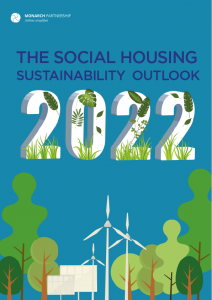The UK will be the first country to make the Task Force on Climate-related Financial Disclosures (TCFD) mandatory. This means that both the public and private sectors will have to prioritise Environmental, Social and Governance (ESG) strategies to secure funding. We look at what the TCFD recommendations cover, and what they will mean for Housing Associations in the future.
ESG reporting in Social Housing
The TCFD recommendations helped shape The Sustainability Reporting Standard for Social Housing. Recently released by a social housing working group, the report aims to help the sector benefit from the rising interest in ESG.
The social housing sector has largely relied on a presumption that it ticks ESG boxes by having an innate social impact. But this clear reporting standard will give rise to more proactive ESG strategies in the future.
To stay competitive, housing associations will have to embrace transparency and sustainability reporting in the future. Not only to tick obligational boxes but to ensure investments in the future. To prepare for this, becoming aligned with the TCFD recommendations is a sensible first step.
What is the TCFD?
The Task Force on Climate-related Disclosures established in 2015 by the international Financial Stability Board. It is based on the growing consensus that climate change has immediate effects on economic decisions. Investors are growing more aware of climate-related risks and putting more faith in organisations that are planning ahead.
In a series of environmental measures from the government, Chancellor Rishi Sunak announced plans to make alignment with the TCFD guidelines mandatory. This fraction of the green recovery plan aims to bolster the UK’s position as a global leader for green finance.
What are climate-related risks?
The Task Force broke down climate-related risks into two major categories: risks related to the transition to a lower-carbon economy and risks related to the physical impacts of climate change.
Transition risks include shifts in policy and litigation, market, technology and reputation. Organisations are already seeing this impact with climate-related litigation and policy changes rising. Costs of operation, raw materials, and products are all vulnerable to shifts in policy, technology, and markets. And changes in consumer preferences and customer behaviour must also be taken into account.
Physical risks involve the effects of climate change on the natural world. These are broken down into two categories: acute and chronic risk. Acute risk involves extreme weather events such as wildfires or floods. Chronic risk refers to longer-term shifts in climate patterns that could affect anything from an organisation’s supply chain to their employees’ safety.
What are climate-related opportunities?
In light of the potential risks posed by climate change, the TCFD also recommends several opportunities. These are solutions that can reduce risk and provide organisations with long-term stability.
- Resource efficiency: Making your buildings and transportation as efficient as possible by integrating intelligent energy management, reducing water usage and consumption, and recycling.
- Energy source: Implementing the use of clean energy sources through procurement or onsite generation and taking advantage of policy incentives.
- Products and services: Developing low-emission goods or services and/or innovative climate-related products.
- Markets: Having access to new markets and assets and use of public-sector incentives.
- Resilience: Boosting financial and reputational stability by adopting sustainable solutions such as energy efficiency and supporting renewable energy.
What are the recommended disclosures?
There are four recommendations laid out by the task force for disclosures. These include financial filings or other reports for potential investors and stakeholders.
- Governance: Disclosure of the board’s oversight on, and management’s role in, assessing and managing climate-related risks and opportunities.
- Strategy: Disclosure of the short and long term climate-related risks and opportunities, their impact on the organisation, and the resilience of the strategy in place to manage those risks and opportunities.
- Risk Management: Disclosure of the organisation’s process for identifying, assessing and managing risks, and how this is integrated into the organisation’s overall risk management.
- Metrics and Targets: Disclosure of the metrics used to assess risks, Scope 1, Scope 2, and Scope 3 greenhouse gas emissions and the risks they pose, and the targets in place to manage risks and opportunities.
What are the benefits of implementing TCFD?
In the future green economy, disclosures like these will be crucial for an organisation’s sustainability and resiliency. Not only will they play a key role in future investment decision-making, but implementing TCFDs will help to identify structural weaknesses within your organisation. This enables you to put in place sustainable solutions to future-proof your business. For the social housing sector, this means safer, warmer and more comfortable homes along with a myriad of financial benefits.
Next week we dive into Sustainable Development Goals (SDGs) and how they shape ESG strategies across the public and private sector.
At Monarch, we have extensive experience with helping housing associations mitigate climate-related risks. Our comprehensive energy management services can help with your TCFD recommendations, from resource efficiency and clean energy to your carbon compliance. Our goal is to simplify your sustainability journey.
For more information on future-proofing your organisation, contact us at Monarch.















